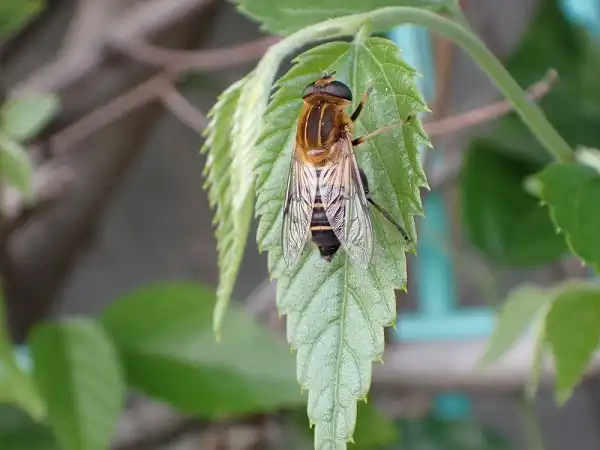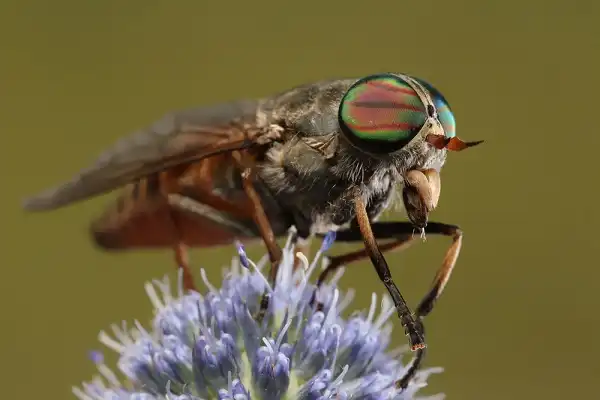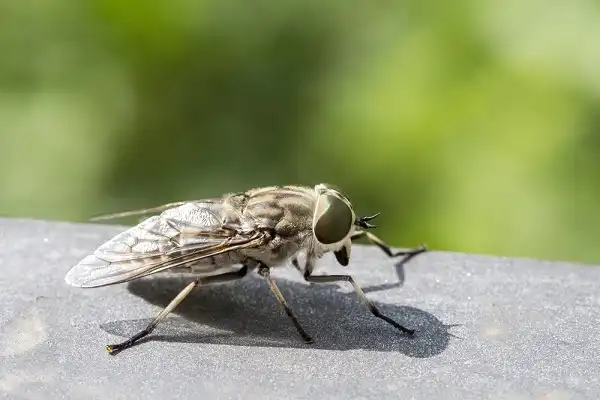Have you ever been out walking and suddenly felt the bite of an unwelcome intruder? If so, then chances are that it was a pesky horsefly. This annoying insect has been known to cause misery for any creature unfortunate enough to be its target. Horseflies typically hover around the head, face, or legs trying to atack unsuspecting victims with their painful bites while simultaneously traonically buzzing in your ear. While they may not carry diseases like mosquitos can, they definitely have a way of making your outdoor activities less enjoyable. Whether you know them as deer flies or horseflies this article is designed to give you some insight into why these creatures make our lives tricky and what we can do about it!

Horsefly Description
Horseflies (or deer flies) are small to medium-sized flies that measure between 5 and 25 millimeters in length. They have a robust body with large eyes, giving them excellent vision. The head of the fly is large and triangular, and it has long antennae which they use to detect their prey. Horseflies also have a pair of wings that allow them to fly swiftly and at high speeds. The color of horseflies varies depending on the species, but they usually range from dark brown or black to yellow or even green. Some species have stripes or spots on their thorax or abdomen which can help identify them from other insects. In addition, many species will also have bright-colored eyes which can help distinguish them from similar-looking insects such as houseflies.
Horsefly Habitat
Horseflies can be found in a variety of habitats, usually near areas with moisture and plenty of food sources. They are most commonly seen near streams, ponds, and marshes, as these environments provide ample opportunity for them to find prey. In addition, they tend to be attracted to human activities such as gardening and outdoor recreation. Horseflies also prefer warm climates and can often be found near the coast or in tropical regions where temperatures remain steady year-round. Horseflies are also known to migrate long distances when searching for prey; some species have been documented flying up to 20 kilometers per day! This behavior is thought to be related to their need for blood meals which cannot be obtained when staying within one area all the time. As such, migrating horseflies can become quite a nuisance when traveling from one place to another during the summer months.
Horsefly Diet
Horseflies primarily feed on the blood of their victims, making them a type of hematophagous insect. They typically target warm-blooded animals such as livestock and humans for meals, but can also feed off of smaller animals like birds or reptiles. Female horseflies require blood to lay eggs and provide nourishment to larvae, while males mostly consume pollen and nectar from flowers. When targeting a human or animal victim, Horseflies will use their sharp mandibles to make a quick incision and then lap up the blood that flows from it. This process can be extremely painful due to the sharpness of their bites as well as an anticoagulant they secrete which helps keep the wound open.

Horsefly Size
Horseflies usually measure between 5 and 25 millimeters in length, making them relatively small to medium-sized. They have a robust body with large eyes, giving them excellent vision. The head of the fly is large and triangular, and it has long antennae which they use to detect their prey. The color of horseflies varies depending on the species, but they usually range from dark brown or black to yellow or even green. Some species have stripes or spots on their thorax or abdomen which can help identify them from other insects. In addition, many species will also have bright-colored eyes which can distinguish them from similar-looking insects such as houseflies. Horseflies generally have a wingspan of around 3-5 cm when fully grown, allowing them to fly swiftly and at high speeds.
Horsefly Lifespan
Horseflies typically have a lifespan of about 1 year. During this time, they will spend the majority of it in search of food sources such as humans or animals for their blood meals. After finding a suitable victim, the female horsefly will lay her eggs in vegetation near water sources like tall grasses or reeds. The larvae then develop in water-logged soil by feeding on organic matter found in rivers or streams. After maturing into adults they emerge from the water and begin looking for food sources themselves. Adult horseflies can live up to around 6 weeks if conditions are favorable, but their lifespans may be shorter depending on the species and weather conditions. In addition, some species will hibernate during colder months and become inactive until temperatures rise again in late spring/early summer. The average lifespan of a horsefly varies greatly depending on environmental factors, but they tend to live longer than other types of flies with similar characteristics. For example, houseflies only live up to 2 weeks while mosquitoes may only last a few days without finding a meal.
Horsefly Behavior
Horsefly behavior is largely driven by their need for a food source, typically blood from warm-blooded animals and humans. Horseflies tend to prefer warm climates where food sources are more abundant, typically near large bodies of water or swamps. As such, they tend to become most active during the spring and summer months when temperatures are high enough for them to hunt efficiently. During this time period, they will often swarm in groups searching for prey which can make outdoor activities quite unpleasant! Horseflies can sometimes become aggressive if disturbed while feeding and will fly toward humans in an attempt to bite them and draw blood. To avoid being bitten, it’s important to wear appropriate clothing such as long sleeves and pants when outdoors in areas where horseflies might be present. Additionally, insect repellents containing DEET can be used on exposed skin areas as an extra precaution against being bitten by one of these pests!

Horsefly Speed
Horseflies are capable of flying at high speeds – up to 20 kilometers per hour. They have robust bodies with large eyes, giving them excellent vision and allowing them to detect their prey from long distances. To propel themselves forward, they use their powerful wings which have a wingspan of around 3-5 cm when fully grown. Horseflies can also fly long distances, up to 20 kilometers per day when migrating in search of food sources like humans or animals. In addition to speed, horseflies are also known for their agility and maneuverability. They can quickly change direction and altitude while in flight, making it difficult for predators or insect repellents to target them accurately. This ability is especially useful when trying to evade capture by humans during outdoor activities. Furthermore, the shape of their wings allows them to generate lift easily so they can hover if need be.
Horsefly Reproduction
Horsefly reproduction begins when female horseflies locate suitable hosts for blood meals. After feeding, the female will lay her eggs in vegetation near water sources like tall grasses or reeds. The larvae then develop in water-logged soil by feeding on organic matter found in rivers or streams. This process can take anywhere from 2 to 3 weeks to complete depending on environmental factors such as temperature and humidity. Once they have reached maturity, the horseflies will emerge from the water and begin looking for food sources themselves. During this time, they may travel up to 20 kilometers per day while migrating between different areas in search of prey.
The adult horseflies can live up to around 6 weeks if conditions are favorable, but their lifespans may be shorter depending on the species and weather conditions. Female horseflies will often mate multiple times during their lifetime which increases the chance of successful reproduction. When mating, males will use their sharp mandibles to latch onto the female and form a tight grip that is difficult to break apart. During copulation, both genders exchange sperm before going their separate ways; however, it is unclear whether or not a male’s sperm is actually necessary for successful reproduction given that females are able to store sperm over long periods of time without fertilizing any eggs.
Horsefly Hunting
Horsefly hunting is a necessary practice to reduce the population of horseflies in certain areas and protect humans and animals from their painful bites. One of the most effective means of controlling horsefly populations is through trapping. Although there are many different types of traps available on the market, one of the most popular is a sticky trap that attracts horseflies with an alluring scent. Once the flies get close enough to the trap, they become stuck on the adhesive surface which traps them until they eventually die off. Insecticides can also be used as a more direct approach to killing horseflies; however, this method should only be used as a last resort since it may also kill off other beneficial insects like bees or butterflies in the area. Another way to control horsefly populations is by encouraging natural predation by introducing fish species such as bass or sunfish into water sources where these pesky flies tend to lay eggs. These fish will consume the larvae before they have a chance to mature into adults, reducing the overall population over time.

Conclusion
In conclusion, horseflies are a common pest that can be found all over the world. Furthermore, they also possess strong agility and maneuverability skills which makes it difficult for predators or insect repellents to target them accurately. Despite their usefulness in controlling other insect populations through predation, many people still find them annoying due to their painful bites and tendency to swarm in groups near food sources. As such, it is important to control these populations early on by using various insecticides or traps that can help reduce numbers until natural predators have time to catch up with them.
Frequently Asked Question


